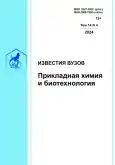Frequency of cry-like genes in Bacillus thuringiensis strains of the Crimean microorganism collection
- Authors: Kryzhko A.V.1
-
Affiliations:
- Research Institute of Agriculture of Crimea
- Issue: Vol 14, No 4 (2024)
- Pages: 567-577
- Section: Physico-chemical biology
- URL: https://journal-vniispk.ru/2227-2925/article/view/302281
- DOI: https://doi.org/10.21285/achb.941
- EDN: https://elibrary.ru/AQLWEO
- ID: 302281
Cite item
Full Text
Abstract
References
- Arthurs S., Dara S.K. Microbial biopesticides for invertebrate pests and their markets in the United States // Journal of Invertebrate Pathology. 2019. Vol. 165. P. 13–21. doi: 10.1016/j.jip.2018.01.008.
- Jouzani G.S., Valijanian E., Sharafi R. Bacillus thuringiensis: a successful insecticide with new environmental features and tidings // Applied Microbiology and Biotechnology. 2017. Vol. 101. P. 2691–2711. doi: 10.1007/s00253-017-8175-y.
- Duarte Neto J.M.W., Wanderley M.C.A., da Silva T.A.F., Marques D.A.V., da Silva G.R., Gurgel J.F., et al. Bacillus thuringiensis endotoxin production: a systematic review of the past 10 years // World Journal of Microbiology and Biotechnology. 2020. Vol. 36. P. 128. doi: 10.1007/s11274-020-02904-4.
- Jo H., Tagele S.B., Pham H.Q., Kim M.-C., Choi S.-D., Kim M.-J., et al. Response of soil bacterial community and pepper plant growth to application of Bacillus thuringiensis KNU-07 // Agronomy. 2020. Vol. 10, no. 4. P. 551. doi: 10.3390/agronomy10040551.
- Perez M.P., Sauka D.H., Onco M.I., Berretta M.F., Benintende G.B. Selection of Bacillus thuringiensis strains toxic to cotton boll weevil (Anthonomus grandis, Coleoptera: Curculionidae) larvae // Revista Argentina de Microbiología. 2017. Vol. 49, no. 3. P. 264–272. doi: 10.1016/j.ram.2016.12.010.
- Soleymani S., Sarrafzadeh M.-H., Mostoufi N. Modeling of fermentation process of Bacillus thuringiensis as a sporulating bacterium // Chemical Product and Process Modeling. 2019. Vol. 14, no. 2. P. 2018000. doi: 10.1515/cppm-2018-0007.
- Guttmann D.M., Ellar D.J. Phenotypic and genotypic comparisons of 23 strains from the Bacillus cereus complex for a selection of known and putative B. thuringiensis virulence factors // FEMS Microbiology Letters. 2000. Vol. 188, no. 1. P. 7–13. doi: 10.1111/j.1574-6968.2000.tb09160.x.
- Hansen B.M., Hendriksen N.B. Detection of enterotoxic Bacillus cereus and Bacillus thuringiensis strains by PCR analysis // Applied and Environmental Microbiology. 2001. Vol. 67, no. 1. P.185–189. doi: 10.1128/AEM.67.1.185-189.2001.
- Palma L., Muñoz D., Berry C., Murillo J., Caballero P. Bacillus thuringiensis toxins: an overview of their biocidal activity // Toxins (Basel). 2014. Vol. 6, no. 12. P. 3296–3325. doi: 10.3390/toxins6123296.
- Fang Y., Li Z., Liu J., Shu C., Wang X., Zhang X., et al. A pangenomic study of Bacillus thuringiensis // Journal of Genetics and Genomics. 2011. Vol. 38, no. 12. P. 567–576. doi: 10.1016/j.jgg.2011.11.001.
- Lee M.K., Walters F.S., Hart H., Palekar N., Chen J.-S. The mode of action of the Bacillus thuringiensis vegetative insecticidal protein Vip3A differs from that of Cry1Ab delta-endotoxin // Applied and Environmental Microbiology. 2003. Vol. 69, no. 8. P. 4648–4657. doi: 10.1128/AEM.69.8.4648-4657.2003.
- Sena J.A., Hernández-Rodríguez C.S., Ferré J. Interaction of Bacillus thuringiensis Cry1 and Vip3A proteins with Spodoptera frugiperda midgut binding sites // Applied and Environmental Microbiology. 2009. Vol. 75, no. 7. P. 2236–2237. doi: 10.1128/AEM.02342-08.
- Bravo A., Likitvivatanavong S., Gill S.S., Soberón M. Bacillus thuringiensis: a story of a successful bioinsecticide // Insect Biochemistry and Molecular Biology. 2011. Vol. 41, no. 7. P. 423–431. doi: 10.1016/j.ibmb.2011.02.006.
- Crickmore N., Zeigler D.R., Schnepf E., Van Rie J., Lereclus D., Baum J., et al. Revision of the nomenclature for the Bacillus thuringiensis pesticidal crystal proteins // Microbiology and Molecular Biology Reviews. 1998. Vol. 62, no. 3. P. 807–813. doi: 10.1128/MMBR.62.3.807-813.1998.
- Van Frankenhuyzen K. Cross-order and cross-phylum activity of Bacillus thuringiensis pesticidal proteins // Journal of Invertebrate Pathology. 2013. Vol. 114, no. 1. P. 76–85. doi: 10.1016/j.jip.2013.05.010.
- Ben-Dov E. Bacillus thuringiensis subsp. israelensis and its dipteran-specific toxins // Toxins (Basel). 2014. Vol. 6, no. 4. P. 1222–1243. doi: 10.3390/toxins6041222.
- De Maagd R.A., Bravo A., Berry C., Crickmore N., Schnepf H.E. Structure, diversity, and evolution of protein toxins from spore-forming entomopathogenic bacteria // Annual Review of Genetics. 2003. Vol. 37. P. 409–433. doi: 10.1146/annurev.genet.37.110801.143042.
- Chougule N.P., Bonning B.C. Toxins for transgenic resistance to hemipteran pests // Toxins (Basel). 2012. Vol. 4, no. 6. P. 405–429. doi: 10.3390/toxins4060405.
- Ohba M., Mizuki E., Uemori A. Parasporin, a new anticancer protein group from Bacillus thuringiensis // Anticancer Research. 2009. Vol. 29, no. 1. P. 427– 433.
- Zheng J., Gao Q., Liu L, Liu H., Wang Y., Peng D., et al. Comparative genomics of Bacillus thuringiensis reveals a path to specialized exploitation of multiple invertebrate hosts // mBio. 2017. Vol. 8, no. 4. P. e00822-17. doi: 10.1128/mBio.00822-17.
- Ye J., Coulouris G., Zaretskaya I., Cutcutache I., Rozen S., Madden T.L. Primer–BLAST: a tool to design target-specific primers for polymerase chain reaction // BMC Bioinfomatics. 2012. Vol. 13. P. 134. doi: 10.1186/1471-2105-13-134.
- Franco-Rivera A., Benintende G., Cozzi J., Baizabal-Aguirre V.M., Valdez-Alarcón J.J., López-Meza J.E. Molecular characterization of Bacillus thuringiensis strains from Argentina // Antonie Van Leeuwenhoek. 2004. Vol. 86, no. 1. P. 87–92. doi: 10.1023/B:ANTO.0000024913.94410.05.
- Willumsen P.A., Johansen J.E., Karlson U. Isolation and taxonomic affiliation of N-heterocyclicaromatic hydrocarbon-transforming bacteria // Applied Microbiology and Biotechnology. 2005. Vol. 67, no. 3. P. 420–428. doi: 10.1007/s00253-004-1799-8.
- Bravo A., Sarabia S., Lopez L., Ontiveros H., Abarca C., Ortiz A., et al. Characterization of cry genes in a Mexican Bacillus thuringiensis strain collection // Applied and Environmental Microbiology. 1998. Vol. 64, no. 12. P. 4965–4972. doi: 10.1128/AEM.64.12.4965-4972.1998.
- Jain D., Sunda S.D., Sanadhya S., Nath D.J., Khandelwal S.K. Molecular characterization and PCRbased screening of cry genes from Bacillus thuringiensis strains // 3 Biotech. 2017. Vol. 7, no. 1. P. 4. doi: 10.1007/s13205-016-0583-7.
- PCR primer design / ed. A. Yuryev. Totowa: Humana Press, 2007. 431 p.
- Хайлафян А.А. Современные статистические методы медицинских исследований: монография. М.: Ленанд, 2014. 320 с.
- Natingga D. Data science algorithms in a week. Birmingham – Mumbai: Packt Publishing, 2018. 214 p.
- Galea A. Applied data science with Python and Jupyter. Birmingham – Mumbai: Packt Publishing, 2018. 174 p.
Supplementary files










